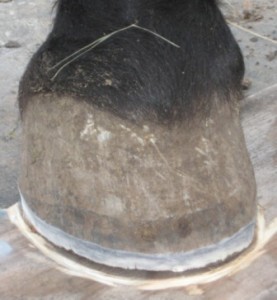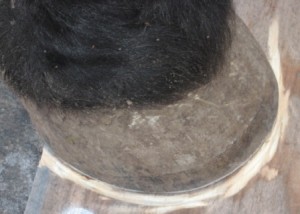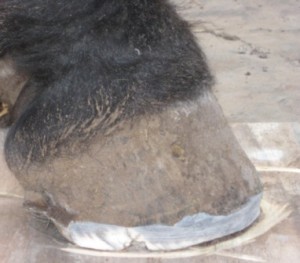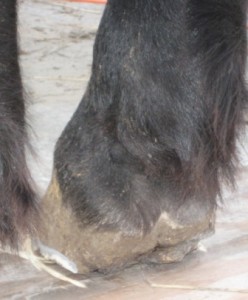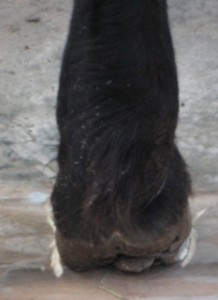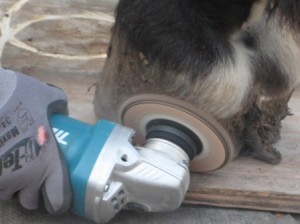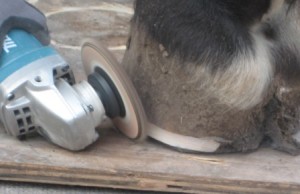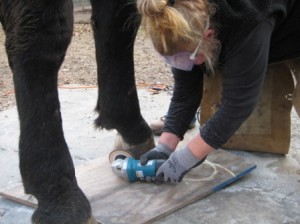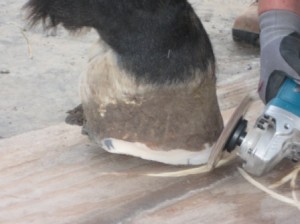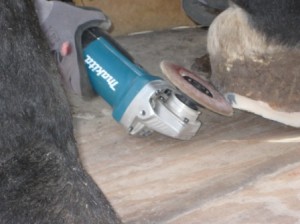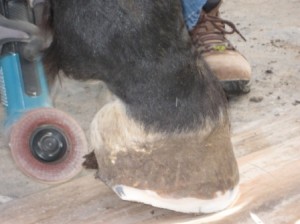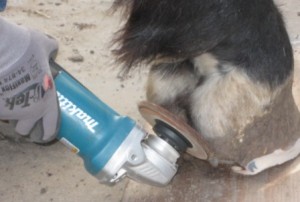What Is “Normal”???
When you start discussing thin soles, you need to remember that sole thickness varies widely based on age, breed, hoof care history, diet – everything is relative!
According to several vet friends, most “normal” horses have thin soles… 10mm is supposed to be average, but 6-8mm may be more “normal”.
Normal for most horses is quite thin relative to a mustang on soft range! Thick soles like we see in some walking horses and mustangs are not normal for most breeds or horses, and exceptions even exist in the gaited horse breeds… sole thickness varies widely, period.
Thick Sole Isn’t Always Good
I have been able to get a very thick sole to accumulate using Epona synthetic shoes, but it sheds back to “normal” once the horse is left barefoot. My friend Asa, in Las Vegas, hates thick sole because in her arid region, it needs to me trimmed out.
Too much of a good thing is a bad thing.
Rehabbing A Thin Sole?
If a horse has a sole that isn’t worn or trimmed to be thin, and you leave a more stout wall &/or protect the sole from wear, then feed a better diet (see www.drkellon.com ! ) and use something like Keratex or Hoof Armor, you may be able to add 1 to 4 mm. Maybe!
In a case where the sole is already a a relatively healthy depth, and the wall height is good, you may not be able to get much improvement.
If a horse has worn his sole thin because his walls have been trimmed or worn short, like most of the thin soled horses I see, or if the sole has been thinned in the trimming process, you can almost always get more sole to accumulate by tweaking the trim, diet and protection. Here’s my checklist:
- balance the minerals www.drkellon.com
- Feed straight grass hay (take away alfalfa and oat)
- boot 24×7 or glue on synthetic shoes or boot shells
- add boots for all exercise if left barefoot
- change the environment to be non abrasive ; add soft dirt, saw dust, move to a soft pasture
- change the trim technique to NOT trim sole and to let the walls get to be 1/8 to 1/4″ beyond the sole
- Try Keratex applied daily. http://www.keratex.net/hoof_hardener.htm “Keratex Hoof Hardener is a gentle acting chemical formulation which forms additional intermolecular bonds between molecules of keratin through the process of cross-linking. Keratin is the main protein constituent of horn and is best described as the building block of the horn structure.”
- Try Hoof Armor http://www.hoofarmor.com/ “Hoof Armor® hoof protection is an easily applied adhesive coating that Farriers and horse owners alike can utilize to protect their barefoot horse’s hooves against abrasion and wear.”
“Normal”???
Again, what is normal for one breed or individual, like a typical Gaited horse or Morgan, would be very thick for a TB or some lines of QH. Sole depth varies. My Marcel, a never shod Arab, has TB type feet, a thinner sole that often needs more protection.
Should You Worry?
I only worry when the horse is uncomfortable in its living environment.
I used Hoof Armor and glue-on Glove shells on Diana Thompsons Timothy, a 29 to 32YO TB with historically thin soles, typically 6mm, and the result was that after 3 years barefoot, he had 12 to 14mm of sole depth. So sometimes it can happen but it really depends on the individual case.
In Tim’s case, we changed his diet and used glue-on boots for 6 months to protect his soles, and when they came off I used the Hoof Armor. He was on a super abrasive surface, so his feet wore down fast and we’d put him back in glue-ons after 5 to 8 weeks. If he’d been on a normal footing they might have stayed good longer… I don’t know.
Best goals are to try to get the horse optimally comfortable, keep the sole from wearing too fast…
Important To Remember:
- Alfalfa often results in a more brittle wall and poor wall attachment. I see this on most horses… the feet almost always get better when alfalfa is removed. Many horses grow a soft wall on oat or grain hay. I don’t know why! Its anecdotal.
- I was skeptical about how much the small amount of alfalfa in the Elk Grove Stable Mix could affect the feet, but have one client who exchanged Elk Grove for straight grass hay pellets and the difference in the amount of wall separation by the next trim was significant. Its anecdotal, but its something you can try.
- Too short a wall trim eliminates traction so the sole is subject to more abrasion.
- Temporarily letting the heel get a bit taller helps relieve sole abrasion. Let the sole grow and you can lower the heel later.
- Using boots 24×7 for a week to 2 or 3 months (with pads and Gold Bond) protects the sole and allows it to accumulate. Once the walls are solid and sole has developed, feet usually stay nice unless the environment is extremely abrasive.
- Thin soles make feet tender and can result in mild inflammation, which appears to cause poor wall attachment and wall flare… vicious cycle! Wall attachment is better when feet are comfortable.
Story…
I trimmed a horse yesterday (large WB type, 1200 lbs) that I have been trimming for 5 months. The prior trimmer was trimming her extremely short, and I expected her to have nice feet in 6 weeks, so I was puzzled. The owner swore she was on straight grass hay diet. Everything else in the diet was perfect,but the mare had persistent stretched white line and I felt she was getting alfalfa! Trusted the owner but… gut feeling…. the wall was smashed flat at the base, and the sole was thin and flat.
I’m impatient. I was wondering if mild solar inflammation was causing the wall separation. This is a huge mare! So last trim, we were talking about putting on glue-ons (size 5!!) on her to get her wall to grow out a bit and decided to hold off, decided to try deep saw dust in the paddock and boots for all exercise. And if that didn’t work, try boots and pads 24×7 to see if it changed anything.
So 4 weeks ago, the owner discovered that the feeders had been feeding her alfalfa as a treat! She’s a big mare – maybe they felt sorry for her!!
She stopped that, and this trim, she had ¼” of straight wall, no flair, and GREAT soles!!!
- I’m writing this article on different types of sole and how to manage it because its a confusing topic to understand.
Its important to be able to assess the state of the sole as an owner, and all trimmers need to be knowledgeable about assessing sole durability and depth. There are characteristics that help us assess this, but if the horse has active laminitis, our assessments become crude guesses because the coffin bone location could change.
SOUND FEET
Sound bare feet are a product of an appropriate diet and are shaped by abundant exercise and the movement patterns of the body they carry. If the body is balanced, the feet are generally symmetrical. If the body has pathology, the feet mirror it.
Regardless of where they live, healthy, sound bare feet have several things in common. When barefoot horses are optimally sound they have a supportive frog, thick durable sole and a low ridge of wall and heel beyond the white line/live sole junction.
How much wall is adequate is variable, it depends on the horse and environment. Some horses accumulate a very thick sole and don’t appear to “want” this lip of wall, but in some feet, that thick sole is an over accumulation.
We need to rely on the horse to tell us what works for them and what doesn’t.
DON’T rely on just lip licking and sighing!! I have witnessed horses undergoing an invasive trim licking their lips, snorting and sighing, and then walking off VERY sore. They are sometimes licking as a sign that the trim is relieving discomfort, but they are sometimes doing it because the trimming is uncomfortable and makes them anxious, much as being in the dentists chair makes us anxious, and they want to encourage us to end it.
The trims I admire and have seen work great look like the trims below. Most of these trims are “transitions”, feet in the first year after having shoes removed.
The September trim below has a very low rim of wall, but for this arena horse it is what works best. This horse works in a soft sand arena and is booted for trail work.
The hoof below is before a 5 week winter trim, and the trim at this level will change the foot very little… most of the wall is shaped by the upper bevel, the bars will be neatened slightly and the lower edge rolled.
The wall is beveled or rolled when trimming so that the edge of the wall wears predictably over a 5 or 6 week cycle and is almost as long at 5 or 6 weeks as it was after trimming. These subtle bevels and rolls allow a skilled trimmer to compensate for imbalance in movement so that the pre-trimmed hoof is still fairly balanced and the boots still fit.
There are differences in feet from swampy wet areas and hot, arid areas, and the differences are usually accumulating sole and frog. In wet areas, the sole and frog exfoliate easily, and in arid climates, they became a thick, tough horn that resists wear. These different characteristics have advantages and disadvantages.
The Virginia hooves below are easy to trim because they are softer and landmarks are clear and specific. The feet have a good sole and adequate heel, wall and bar for traction, and the frog is lush, wide and open. BUT this hoof can be tender on hard gravel surface, and because the horn (calloused parts of the sole and frog) is softer, it wears faster.
The Nevada hoof below has a thick, hard sole, but its more difficult to see the sole depth. Its durable and tough.
The Nevada hoof below, in contrast, has an over accumulation of bar and sole. Not only is it hard to tell what needs to be trimmed, its physically VERY difficult to trim… these feet are like granite.
The Belgian hoof above, is shaped by a slick winter paddock. The slightly prominent bars have a natural function, they provide traction in the slippery environment. If the walls are trimmed regularly, the bars self maintain at this length. When the walls are allowed to get excessively tall, the bar also accumulates and must be trimmed when the wall is trimmed. A well beveled wall wears at about the same rate it grows at and this balanced wear should allow the bar to wear at the same rate.
The hoof from the Northern California trail horse below is shaped by hundreds of miles ridden bare on lava rock and hard packed trails. The heel is trimmed to be well above the sole to make the horse more comfortable going over gravel, to reduce sole abrasion and to add to traction. Untrimmed, this hoof looks very similar at 6 weeks to what it looks here. It was prettied up for pictures but belongs to a professional trimmer who merely touches it up occasionally.
INVASIVE?
So you’ve seen some conservative trims, above. Lets look at the opposite.

This looks invasive to me because a “scoop” was carved into the lateral wall. I’ve see this technique result in extreme lameness
“Invasive Trimming” is a judgement call because trimming that is invasive on one foot may be necessary on another. Most trimming approaches taught in the US are conservative, but unfortunately one popular approach is invasive and is being taught to beginners who don’t have the experience to know when to stop trimming.

This is probably invasive for barefoot in most dry areas, including mine, and probably okay for shod feet is the wall edge was rasped down. It may be fine as in in boots or on a very soft damp footing. Callous has been removed but the sole still looks fairly thick.
“Invasive” procedures involve cutting into the passive (not weight bearing) bar, removing protective sole, taking the heels down to the live sole plane and shortening the wall in a way that leaves the sole over exposed to wear.
Sometimes rehab feet need what could be, for some feet, considered an “invasive” procedure, such as trimming an accumulation of bar. A routine shoeing trim is technically invasive if your intent is to leave the sole unprotected by a shoe or glue on appliance.
So what to trim or not trim if you aren’t sure? Less is more in most cases. If you don’t know and aren’t a professional with a lot of experience, get advice from a conservative trimmer or farrier, or join a conservative trim group like PHCP http://www.pacifichoofcare.org/.
Most importantly, carefully observe the horse before and after the trim and have your objective be a more comfortable, balanced and relaxed stride. The horse will always tell you, you need to listen.
My rule now is that, ideally, the horse should be MORE comfortable after the trim than before, or at least as comfortable. If the horse is sore / more sore, the trim could be the reason. Not always, though!

This is invasive in my area for barefoot, the horse would be very tender for weeks, but may be okay shod
HINT: If there is a large group of people attacking your trimming guru as being invasive, try to get a second opinion on their approach from another organization! I’m closely aligned with AHA and PHCP but have a lot of respect for trims taught by many other groups. There are many ways to learn, choose a method that focuses on your horses health and comfort.
Beginning trimmers shouldn’t be doing anything that is invasive.
I learned from an invasive trimming school that taught hoof mapping; unhealthy feet were over-trimmed to look like what the trainers felt the “healthy” hoof should look like. These horses were uncomfortable, and I was told that discomfort was part of healing and was natural. I started learning from Pete Ramey, and never looked back as I learned that “transitioning to barefoot” can be easy and comfortable.
Now I understand that the people who initially taught me were caught up in their method of trimming and constantly over-trimmed horses. They trimmed sole and bars aggressively, micromanaging feet, and made excuses for why the horses were so sore.
TRIM CONSERVATIVELY…
I’ve trimmed professionally for a more than a decade using a conservative trim approach. I seldom trim sole and attempt to leave a margin of wall that protects the edge of the hoof and provides traction. As a result horses with healthy feet are very comfortable on their home ground barefoot, and many go barefoot on the trail year round.
I look for long relaxed strides at a trot and canter with nice, heel-first landings to assess movement.
Some horses have thin or sensitive soles, or inadequate wall, and need protection. Most of the time, horses coming out of shoes are comfortable without protection in their living environment, but if they are sensitive, they get boots or glue on shoes. Most horses with philological problems are comfortable barefoot or booted if the trim is conservative and appropriate protection is used.
Most horses can grow a thicker more durable sole with the correct trim and diet, but many still like front boots for performance work for the first year or two. Some horses have limited ability to grow a thick enough sole to be barefoot for performance because of past hoof care, breeding or pathology.
HOOF PROTECTION
I see many photos of horses online who have either had their soles aggressively thinned by owners with good intentions, or whose walls have been trimmed, chipped or worn so short that the hoof has inadequate traction resulting in soles becoming dangerously thin. These are the horses and owners we need to help.
When a horse has a thin sole, it needs hoof protection to move comfortably and rehab successfully. Traditionally, nail on shoes were used, and now we have many alternative ways to protect feet for recreational, performance and rehabbing horses.
Synthetic shoes, casting and glue on boots provide a semi-permanent alternative that stays in place for an extended period of time.The primary advantage is that they avoid concussion and flex more than a metal shoe. Boots and pads can be left on for days or weeks, and should be checked daily. Epoxies and sole treatments also help protect feet depending on the condition and terrain.
For more information on hoof protection:
Hoof Boots http://www.healthyhoof.com/articles/Boots/BootOverview.php
Rehab Hoof Protection http://www.healthyhoof.com/articles/RehabProtection.php
Gluing On Boots http://www.healthyhoof.com/articles/Boots/gluing_on_boots.php
HOOVES CHANGE SEASONALLY
The following pictures are the same hoof taken at different times of the year.

This is is a mid-winter hoof from an Arab on pasture
I live in North/Central California. We have very wet winters that start in October and last through March and April. Winters here are as wet as Washington DC and Virginia, where I grew up. Summers are very dry, with almost no rain but occasional coastal fog… the soil is a mixture that can be lava rock, granite, loam or sand.
I rarely have to trim sole in this part of North / Central California. In the summer, a thick sole accumulates and protects the hoof from all of the rock on our trails, and before it can get too thick to create a problem, we have wet weather that encourages the accumulated sole to shed.
Some regions are extremely arid and sole builds up in a dense, hard layer that can make horses very tender.

LasVegas hoof pre trim
Some trimming schools advise removing any sole that isn’t “live”, but where does “live” sole start? What is “false”?? What is a thin sole, and what is normal? And why remove any protection at all?
APPEARANCE
The soles appearance varies widely
Sole is sole; the term “false sole” is misused and after reading a too many ABC FB shares, I’ve decided to stop using it because it implies that it needs to be removed, and it usually doesn’t unless you live in an extremely arid region like Last Vegas.
When Sole accumulates I call it “retained” because, for some reason, the hoof has opted not to shed it.
Pathological Sole Retention
I see sole retention when a horse with hoof pathology first comes out of shoes… sometimes they retain this sole for 3 or 4 months as the hoof rebuilds itself from the inside out. I used to trim it out, and the horse was always more tender and the feet rehabbed slower, and the horse did better in boots. With these feet, I leave the sole in place but sometimes thin it **slightly** with my sole nippers or a sharp knife to add a little passive concavity. I do very little. When it starts popping out, I help it as it pulls free but leave chunks that are resistant in place.
Environmental Sole Retention
The retained sole that makes me crazy is that found in horses that live on stall mats without shavings or in arid locations like Las Vegas. Even feet with great concave sole shapes will pack solid and flat, and the heels contract…
I think these are the hardest feet in the world to trim, physically (super hard sole) and intellectually because its difficult to know how much sole to remove unless you trim this type of hoof a lot.
I see them primarily on horses that live on mats, and I have trimmed the retained sole, not trimmed it, relieved the bar slightly, nothing seems to work well!
I usually ask people to move their horses or change the stall footing, treat it like I do dietary problems like barns that only feed oat and alfalfa… if its a problem for the horse, I ask the owner to move the horse. Asa, in Las Vegas, doesn’t have this option!
Thrush Sole Retention
Some horses have had chronic thrush and end up with retained sole that seems to grow to isolate the super tender frog from the weight bearing surface and any flexing in the tender frog area. I help the client fix the diet and treat the thrush, and this sheds out in a month or two.
Solar Abscess
If a horse has a solar abscess that covers the whole sole, the hoof repairs itself and eventually sheds the sole in one large piece. It may look black and gross under the shedding sole, but I’m not in a hurry to wrench it off!
Unknown Cause
I had one horse who only retained sole in the lateral side of one hoof, all the other feet looked great. The horse was very slightly off on that foot barely noticeable… after 3 months, the owner insisted that I knife it out, it was rubbery and durable, the horse resisted, but I did as she asked, leaving much of it but adding some concavity, and the horse went lame immediately.
Vet xrayed the foot and the lateral edge of P3 had a fracture. we casted DM (dental impression material) into the sole and the horse was immediately better. She retained sole in that area for a year, it finally shed and the mare was sound.
HEALTHY RETENTION
My horses shed sole in moist seasons and accumulate it in dry seasons, and because this isn’t excessively arid like Las Vegas, I leave the accumulated sole alone. If it starts to chip out and is loose, I’ll remove chunks, don’t like to leave pressure points! But I let it shed out naturally until its loose.
ARIES TRIM
Occasionally horses are so uncomfortable that they are unable to lift one or more of their feet for trimming. Examples of scenarios I have run into include:
- Horses with musculo-skeletal problems (arthritis and muscular problems) in their back, shoulders or hips
- Horses with laminitis
- Horses with joint problems like bone chips in the knee (common in older OTTB’s and jumpers)
- Horses with hock problems or stifle problems (common in Gaited horses)
- Horses with extreme ulcers
- Some PMU mares who have never learned to lift their feet for trimming and are too big to struggle with
THIS CASE STUDY
Aries, a +17h Draft TB cross, had a very strong passion for living, strong enough that he loved life fiercely in spite of having most of these problems
He had chronic laminitis with severe coffin bone degeneration, along with many musculo-skeletal problems, stifle and joint problems.
His feet and body were so uncomfortable that he was unable to lift his feet for more than a second or two…. but if he got loose, he would canter away at full speed! He had to be walked with a muzzle on because he was so large that he would literally drag people to the nearest patch of grass…
The only reason he lived as long as he did in this state was 1) his pervasive will to live, and 2) he had excellent support from his boarding stable owner and the other horse owners at the boarding facility (who pitched in to help when needed). His owner had financial constraints. so body-workers, trimmers and the boarding facility owner, Michelle of Harvest Moon Ranch, http://harvestmoonranch.net/, volunteered to help when we could.
BEFORE YOU START
Angle Grinders have four characteristics that make them dangerous to use around horses:
- They generate a blast of air that startles horses… this usually creates the most problems
- They are loud
- They vibrate
- They revolve at a high speed and can easily get bound-up in a horses tail, trimmer hair, lead ropes etc
There are several approaches to using an angle grinder to trim. There is a lot of information online to help you choose tools; search for ” grinder hoof trim” and be prepared to read! I suggest that anyone wanting to try this do their research and practice technique ahead of time with wood, plastic and rubber to understand how the different materials affect your ability to hang on to the grinder.
MY GRINDER PREP
- I remove the grinder shield and post handle
- Always wear protective glasses
- Tie up long hair on the trimmer and the horse
- Wear gloves
TRAINING THE HORSE TO STAND FOR TRIMMING
Grinders throw off a sharp blast of air, and this is the one characteristic that has the potential to alarm horses.
I stand 4 feet from the horse and have the horse on a long loose lead.
I turn the grinder on and off several times, letting the horse watch and get used to the noise, but not showing it to the horse or making a big deal of it.
I then turn the grinder on and “fan” my face with the air, making happy “ahhh!’ types of noise. I then do this to the owner and anyone else standing by….. I blow their hair around and laugh. Sounds silly, but it works.
With the grinder off, I let the horse smell and inspect it
I stand back, turn the grinder on, I fan my face, the owners face, and the the horses face, and, from a few feet away, fan the horses body and legs.
I don’t restrain the horse forcefully, my goal is to engage the horse so that they trust me and the grinder.
THE TRIMMING PROCESS
TOOLS – I use a heavy duty Makita angle grinder with a paddle switch. My preferred disc is a 40 or 24 grit flap disc, but I have used an abrasive stone disc also. There is a lot of information online to help you choose tools.. search for ” grinder hoof trim” and be prepared to read!
ENVIRONMENT – I stand horses on a piece of plywood to trim. The grinder flap disc has to go to the ground to get a clean edge on the bevel, and most other surfaces create problems or present hazards. Rubber mats catch the edge of the flap disc and can jerk it out of your hand, metal makes a loud noise when the disc is pressed against it, dirt and sand get thrown up and can get in your eyes or spook the horse. Concrete or asphalt can be used, but a pattern of the horses foot will be left on the surface.
HORSE HANDLING – I also like to work in an open area so the the horse can move away from me if it startles or spooks. I ask the handler to stay alert and stay by me, on the same side of the horse that I’m on. If the horse is the least bit active, I have any observers stand on my side of the horse, behind me and at least 3 feet away.
TRIM OBJECTIVE – The objective is to use the edge of the flap disc to etch a bevel around the edge of the hoof from the lateral (outside) heel wall to the medial (inside) heel wall. Depending on the angle of the hoof wall and the wall thickness, the bevel will be from 1/4 to 1/2 inc high.
The angle of the bevel is roughly perpendicular to the ground.
The top edge of this bevel should parallel the coronet band or growth ring around the front half of the hoof.
If the horse has high heels and is able to life his heel, I get the horses foot at edge of the plywood so the the heels are hanging off the edge, and try to bevel the heels down with the grinder… this sometimes works ok, sometimes doesn’t work at all! Each case is different.
TRIMMING
When the training and desensitization goes well, I run through a mental check list, then have the horse holder stand on the same side of the horse as I am on, and I turn the grinder on and, working on a front foot, I lightly touch it to the lower edge of the wall, where the bevel will be. By this time the horse is usually alert but relaxed, and I can continue around the front feet, and then the back.
Healthy Frogs Make Healthy Bare Feet
My Horses & Clients Feet

Northern California, November 1, 2009
I started this to show my frogs but expanded it to include frogs from around the world. Check out the International Healthy Bare Feet page too!
My horse, Gabby’s feet (Arabian)
Clifford (young QH)
Magnum (retired QH)
Martha & Dixie (QH and TB)
Timothy (retired TB)
Gulala (retired TB)
Viggo (middle aged TB)
King (Morgan-cross Mule that gets LOTS of riding!)
Honey, Belgian PMU Rescue
UB, Dressage Pony
Global Healthy Bare Feet
These case studies are horses with healthy frogs along with a brief bio for each horse Above, Gabby’s rear feet, trail ridden 15 to 30 miles a week, usually barefoot behind. Gabby lives in a rich pasture and is muzzled March to July. I wish I had left a little more heel height. His frog shed 4 weeks earlier so this frog is immature.
.I have been grinning over super nice (sometimes immature) frogs for the past few weeks and started taking pictures of them to share. Most of these frogs shed out in late August or September and are coming back in great now. Some are well developed, others are still immature. They all look super to me. these trims aren’t picture-book perfect, but they are extremely functional, and thats what counts.
I sometimes spend as much time on the frogs’s as I spend on the rest of the hoof when I trim. I nipper the core out of the central sulcus, nip any flaps, open cracks up and treat thrush with Usnea tincture if I see any. If I find thrush, I nipper off as many flaps as I can with Bonsai tools. and treat with Lysol spray.
How aggressive I get opening up cracks depends on the season, conditions, environment and how close the frog is to shedding again.
Why I Wrote This Article
I moderate the Whole Horse Health Yahoo list http://pets.groups.yahoo.com/group/wholehorsehealth/ . We had a thread going on in September on Thrush, and I sent in a post that included this comment:
“Everyone wants to ignore or downplay the impact of thrush. The expensive A Circuit Jumper, case study below, was seen by many top vets and vet clinics, was shod by “the best” and was finally given away, free. Great story on the consequences of ignoring our horses pain…
http://www.healthyhoof.com/case_studies/Freedom/Free.html“
I got the following post from a member whose posts had gotten tiring for many members. She had made prior comments stating that thrush isn’t really a problem. I decided to hold this particular post back. Still, I was dismayed that an experienced trimmer could be so willfully blind to something that I ***know*** is a serious problem!
…… I don’t see thrush in these feet and to be honest the shoeing and trimming underneath it doesn’t look poor either.
…. So not to discredit anything you are doing, the trim looks great btw, I just don’t think the claim of thrush RX cured this horse is accurate and it could be.
This horse, picture below right. had thrush that was so painful he threatened to kick when the foot was cleaned, his frog and digital cushion were extremely sensitive, and the hoof pick sank 1/2 inch into the deep crack that penetrated his digital cushion. You can see the deep crack on the Freedom case study that she referred to.

When I look at this case study, I see nothing but thrush and a horribly unhealthy frog!!!! The fact that someone who claims to trim 200 horses in wet east coast weather could see this and not recognize thrush? I was blown away. Appalled. A good trimmer needs to know the many components of soundness.
This was one very unhealthy foot on a very uncomfortable horse. The horse didn’t want us handling the thrushy foot at all; he pulled his leg, threatened to kick and refused to stand still.
http://www.healthyhoof.com/case_studies/Freedom/Free.html
We did clear up the thrush after a few months of treatment, and the horse regained total soundness, but he later coliced, twisted a gut and had to be put down.
So my message is “Just because someone has a well known name, credentials, a web site, trimming DVD’s … it doesn’t mean that they know everything.”
Myself included! I still have a lot to learn. We each need to think for ourselves, professionals and owners. Question whatever person you call an authority. Question your own assumptions. For the horse. We each need to learn the difference between painful unhealthy frogs and healthy frogs, and how unhealthy frogs affect movement and comfort.
Don’t settle for unhealthy frogs!! If your trimmer can’t figure it out, you may have to. Unfortunately Certification or being on some online list doesn’t mean a trimmer is a guru about everything. Frogs are important, no matter what climate you are in.
Do YOU have healthy frogs you want to share from your area?
I really want folks to get this deal about the importance of healthy frogs, so if you have healthy frogs to share, email two to three pictures, your area and a brief bio to me at healthyhoof@comcast.net.
THRUSHY UNHEALTHY FROGS
To see Healthy Frogs in perspective, you may need to look at unhealthy frogs first.
Four or five years ago, I was trimming at a clinic in Lake County, Ca, and someone asked me if their horse had thrush… the frog was “okay” but had this black greasy sulcus crack, and it was really tender…. I wasn’t really sure!
After that, I started looking at thrush seriously. I talked to Pete Ramey, and he suggested Pete’s Goo (triple antibiotic ointment and athletes foot cream, see Thrush Treatments page )
When I realized that perhaps a third of my client horses had thrush to some extent, I was determined to turn that around, and it’s taken time and perseverance, but I have.
The following symptoms often tie directly to thrush:
- Chronic high bar, heels & retained sole growth to relieve pressure on frog
- Medial /Lateral imbalance ( Wry feet)
- Base-narrow stance &/or sore shoulders
- Ulcer horses often have thrush, and vice versa
- Horses that won’t walk-out going down-hill
MORE INFORMATION ON UNHEALTHY FROGS
Freedom – This horses real name was Liberty, and he was a valuable A Circuit Jumper who was almost euthanized because he had thrush. A friend rescued him, we cleared up all of his problems, and he unfortunately coliced and died in early 2009. Great story.
Thrush – Pictures of thrushy feet, more information on thrush.
Samson and Medial Lateral Imbalance – had severe thrush for long enough that his coffin bone was modified
Thrush Treatments a few of the many ways to treat thrush with comments on things I DON”T use, including bleach, thrush busters and coppertox. Other stuff, like Dry Cow Teat medicine, Albadrys and colloidal silver work too, I’ve just never used them. I try to steer clear of anything with penicillin (Dry Cow Teat medicine & Albadrys ) unless I absolutely need them because I worry about ending up with resistant strains of bacteria in my horses feet!
How My Clients & I Keep Frogs Healthy Today (November 1 2009)
Getting a good heel-first landing impacts how healthy the frog is because it results in optimum blood circulation. A horse can’t land heel first if the frog is a source of pain. It can be a vicious cycle!
I strongly recommend that clients feed low carb forage and pellets, and to keep horses off stressed or rich pasture.
Great frogs don’t happen overnight! When clients resist cleaning and treating frogs or resist dietary changes, I take pictures of feet, repeatedly point out diet-related frog separation and thrush (along with the associated wall and white line separation) and other signs of mild laminitis that may be part of the problem.
I also recommend that clients provide a dry or drained place for horses to stand in wet weather, and all of them have done this. I trim all flaps and grooves regularly, keep the frog neat and look for thrush during each trim. Clients scrub feet with Dawn Dish washing detergent and a brush at any sign of thrush or when feet start stinking, and many cut off frog flaps that appear between trims. That isn’t necessary because I do a thorough job when I trim, but once clients recognize how important a healthy frog is, they like to participate.
We use Usnea, Pete’s Goo, Oxine and Dawn to control most thrush. See Thrush Treatments for more treatments!
DIET AND FROGS – Go for low-carb forage & pellets, balance minerals or feed a zinc/copper supplement, eliminate iron, & watch the pasture!
Diet has a ***huge*** impact on frogs, soles and walls… diet is probably one of the most important factors along with good frog trimming.
Most of my clients follow my advice and feed low carb forage and pellets, most balance their minerals, and most are very careful with stressed or rich pasture. I see diet impacting EVERYTHING now, from ulcers to skin problems to wall attachment…. most of my clients follow my recommendations so I get awesome frogs.
Thrush Elimination …Whose Job Is It?
My opinion is that it’s the Trimmers job to inform a client when their horse has thrush as well as to clean up the frog so that treatments will be more effective. If a horse has a super painful frog infection, the owner may need to soak or otherwise treat the thrush so that the trimmer is safe working on the frogs. I use Usnea Tincture to help relieve pain in frogs I’m trimming, but if the infection is serious, it may not be adequate.
Owners need to be responsible for diet changes, if necessary, and for treating the thrush aggressively enough to clear it up.
Trimmers only see a typical client horse for 20 to 60 minutes a month, not enough time to be solely responsible for frog condition… owners need to actively participate! Learning what remedies are available and using them, talking to your trimmer about alternatives…
I have dealt with many horribly thrushy frogs over the years, and they CAN be cleaned up,
A Comment About Fall & Winter Bars
When you look at these pictures, you’ll notice a slight bar ridge on most of the feet. I make sure bars aren’t loose and shedding, ensure that they are passive to the wall, but leave a bit of bar ridge, especially when its wet and muddy.
Why? Those bars provide **great** traction in mud, and at this time of the year, when the frogs and sole calluses have just shed, they provide a bit of support for the interior of the hoof as well.
On Gabby’s pictures, his soles are thinner than optimum and the bar is coming up to provide a bit more protection. The hoof is an amazing thing to really watch.
Gabby aka Gavilan
Gabby is my teen-age Arab gelding (born spring 1994) and he’s been with me since he was weaned… he’s my “magic horse”, my soul brother. He has 900 AERC miles (we need to correct a few misspelled name records!) but most of my riding is trails, for the sheer pleasure of it.
He was shod at 4 years when I started really riding him, and was shod on the fronts until 2003, when I pulled all of his shoes for the first time. He had occasionally gone bare behind. Gabby’s the reason I went barefoot, and the story is funny…. Gabby & the Farrier
Gabby loves life and is always “smiling”…. I adore him and he knows it!
Gab lives on a 20 acre pasture 1 hour north of San Francisco. The mixed pasture was a dairy field at one time, and is covered in large patches of water during the rainy season (approx. late November to May), and while much of the rolling but mostly flat pasture is not in standing water, much of it is covered through the whole rainy season. When the boys come running in to see me in the winter, their feet throw up water most of way! The do a lot of wading, and it doesn’t bother their feet or frogs at all.
The pasture forage does create problems. Gabby and my other two retired Arabs lived off pasture forage alone June 2008 until October 2008. From October 2008 to June 2009, I usually let them on the pasture muzzled. If it got below 40 degrees at night, I pulled them in and fed them grass hay in paddocks. By the end of spring, Gabby’s feet were okay but the wall integrity was soft. It wasn’t the water in the field, it was the stressed grass.
This year Gabby is coming off pasture any time the grass gets the least bit rich because I want his feet to stay durable. My remaining aged gelding, Shatirr, will go out on pasture more because he needs more calories, but will be muzzled. I had to put my other sweet old guy, Kadanse, down on July 7 2009… Sad day.
I trail ride Gabby, mostly on very rocky trails, and we ride from 10 to 30 miles a week most weeks. Lots of hills and single track, but always some fire roads as well. In past years, when I used Epics and Easy Boots, they were harder to get on so I had him barefoot most of the year, and he did super. This year **I** got addicted to the EasyCare Gloves because they are so easy to use – and he moves awesome in them – however his feet didn’t condition as nicely as they did in past years. I’m trying to wean us both off the Gloves a bit, to use them only when he needs them.
So I’ve started riding him barefoot more, and he hasn’t had boots on for the 50 miles ridden before these pictures were taken. We ride on a lot of cobble stone at one park, lava rock at another, and soft trails with lots of rocky stretches at another. Rock is everywhere up here!
The frogs in these pictures shed last month so are immature but have great shape. His sole is thinner than I like because he shed his thick summer sole callous last month and is on a damp pasture so his sole is wearing more temporarily, but as I watch his feet, the stimulation is encouraging more sole to grow. He does fine barefoot on all but the super rocky roads in this area.
These healthy frogs will hold up great over the winter, no matter how much wading and mud Gabby gets into!!
I’m not saying these are the worlds best feet by any means… they aren’t. And this better not be the worlds best trim because its a fast, but carefully done. trim… not a “special for the camera” trim. Its what I do now on feet like these. I love the fact that Gabby is very comfortable in his bare feet on most trails.
These feet really work for Gabby. Because the fronts were booted (I love the easy Gloves!) most of the season, and he’s shed his sole callous, so his sole is thinner, but these feet are super comfortable for him to live in, and, booted or bare, he IS super sound.
The healthy, if immature, frog is part of the reason. On a scale of 1 to 10 with 10 being great, this frog and sole is about a 7 or 8. Walls are an 8.
…
…
…
Clifford
Clifford is a young QH who came out of shoes June 2009. He had a lot of imbalance from poor shoeing, but no real problems. His heels were a bit contracted from the shoes, but have opened up nicely.
His owner John rides him quite a bit, and he is 30 says into a 90 day Reining training program, full-time training.
John was VERY skeptical about taking his main riding horse barefoot; none of the western folks he knows have barefoot horses, and he was open about his concerns about sending Clifford into training barefoot.
Clifford has done awesome, though, the trainer is very happy with his movement, and he never needs boots for his arena work or for walking on the graveled roads at the ranch. John does boot him for trail riding, and probably will until next summer.
Clifford and Magnum (below) live together on a 1 acre pasture that holds 4 horses. The soil is slightly sandy and slightly sloped, and they are fed a grass hay forage.
………
Magnum
Magnum belongs to Clifford’s owner, and is a retired gelding who had been barefoot for a year but had super long toes, wall distortion and a very rough trim when I first worked on him.
I added his pictures because they were an interesting contrast to Clifford’s. When Johns 3 horses went into this pasture in the early spring, it had been empty and had lush, tall grass. Magnum (and Cassidy, the 3rd horse), shows some wall separation in these pictures as the last of this wall grows out. The fact that he shows wall separation may be related to the long walls and toe, but Clifford was getting a lot of riding and that may be why he didn’t have wall separation.
Magnum had ring bone for a few years, and since starting this trim in May of this year, he has gotten sounder but is still an older retired horse. Not uncomfortable, he has some arthritis but probably could be ridden lightly. He is comfortably pasture sound.
Magnum’s whole body has changed since I started trimming him… just being barefoot isn’t enough! A bad trim has the same deleterious affects on a horses health and movement as a poor shoeing job. His toes were at least an inch too long, his heels were high and contracted, so his stance was base-narrow and his shoulders were sore.
Not all barefoot trims are the same, not all trimmers have the same skills and knowledge. Our differences are great as long as the horses are sound or moving comfortably, but that isn’t always the case. Its always okay to ask questions and want to learn more about your horses feet.
…….
Martha (15 years) & Dixie (5 years)
These pictures are interesting for several reasons. I started trimming these mares in the early spring of 2009, when they both had very long toes and mild laminitis from the pasture they lived on, and I believe they were fed alfalfa, oat hay and higher carb supplements. Their owners, a very conscientious young couple, got serious about diet as soon as we talked, and changed them over to a low carb forage & pellet, but weren’t in a position to do anything about the stressed pasture they lived on immediately, hence the wall separation and stretched white line that is still growing out.
They ride a fair amount, at local parks, often at the beach and recently at Yosemite. Dixie is in Renegade boots because her feet too round for the Gloves, Martha is in Gloves. The owners “use boots as needed” on the front feet, like most of my trail riding clients. (endurance rider who like to trot and canter a lot typically carry or use rear boots).
What’s most interesting about these feet is they are about 90% of the way through growing out the bad wall, and still have a tiny bit of separation in the frogs too… not bad enough to treat, but enough “frog separation” that I needed to trim some flaps each time I’m there. This stuff is generally diet related..
,,,,,
…..
Timothy
Timothy is a 30 year old TB who owns and is owned by Diana Thompson, a great client who is an acupressure specialist and teaches body working.
Diana also has a comprehensive book on Acupressure for Equines, which I own and use regularly. Check it out!
Many of my clients used Diana for their horses body work, saddle fitting or had been to her acupressure clinics. Because their horses are moving so well barefoot, they mentioned me to her, but Diana was VERY skeptical about barefoot before we talked because she would see so many barefoot horses who had been invasively or incorrectly trimmed as a body worker… she had seen a lot of barefoot fanaticism but many of those fanatics had sore footed horses.
What she had gotten used to was horses whose feet would all be so sore that it was hard to diagnose a specific lameness, but as a body worker, Diana could see it in their stiff, sore bodies. Not all barefoot is the same. Invasive or inappropriate trimming can make a horse sore. Forms of this are over thinning the walls, leaving heels or toes too long, thinning the sole or removing supportive bar. Or NOT treating thrush and frog infections! Bad hoof care often results in sore bodies.
Timothy has been shod his whole life, and Diana had tried taking his shoes off once before, but Timothy had horrible problems with the transition and Diana almost lost him.
At the end of April, 2009, after seeing work I had done on many common clients, she invited me out for a Timothy Consultation. Diana and Timothy are close, and after the consultation, when she asked me to pull his front shoes, I felt honored and a bit intimidated.
Timothy is still a super athletic horse even though at this point he is in his 30’s, but he is also fragile, and the footing at Diana’s barn, a very abrasive sharp gravel, meant a lot of booting and casting early on, and use of Hoof Armor more recently.
…..
Gulala
Gulala is an older TB rescue, very retired, who has a well balanced low carb diet and lives in a large paddock with several other mares. This paddock is in an area that doesn’t drain well, its essentially a flood plain near a creek, and the pen gets extremely muddy in the winter. It is picked out on a regular basis, and most of these horses feet are picked out and checked daily.
The boarding stable manager is working towards improving the footing in all the paddocks, but in the winter, these paddocks get very swampy . They lay deep wood chips to keep the horses feet from being down in the mud all the time, and it works well.
This environment is one of the hardest to fight thrush in, and when these horses do get thrush – particularly if there is something else going on line an immune system problem or Cushing’s – cleaning it up is tough. This frog is proof it can be done. This owner has done a super job at getting this frog healthy!
Viggo
Viggo is a mature OTTB who lives in the same environment Gulala…. I’m adding these pictures because his bars were lose and I just scraped them off It also shows how I trim frogs…
….
King, Morgan Mule
King is a young Morgan cross mule who gets **lots** of riding. He also lives in a wonderful “Paddock Paradise” with his donkey buddy, and moves nonstop.
He’s also one of my favorite clients (I say that about many of “my” horses and mean it!)… he’s a super animal in every way. VERY well trained, lots of character. I adore him.
Most of his riding is on trails. His owner packs with him, trail rides 4 to 6 days a week, many long distance rides, barefoot on all terrain (lava rock to shale to cobble stone) and he does awesome. I gave her a pair of EasyCare Edges for her birthday in case she needed them for a recent camping trip to a place that has particularly treacherous rock, and she didn’t need them.
He also gets shown and does very well. He was at Bishop Mule Days and the Sonoma Equine Extravaganza this year. He has a bit of driving training and goes English or western.
King has a slight twist to his right rear leg and has a “curl” on his frog. He gets regular chiropractic and bodywork, has saddles that fit, etc. He’s extremely sound.
He has a tight sulcus and if we didn’t keep it trimmed it would get thrushy.
……….
…….
Honey, Belgian PMU Rescue
Honey belongs to my friend Michelle at Harvest Moon Ranch , and a neat lady named Lisa Bishop does her trimming.
Lisa is a very talented trimmer but is also a VERY talented natural style trainer, and she started trimming Honey because Honey was cleaning up the paddock with my Chaps! She’s HUGE!
Lisa, OTOH, weighs a third of what I weigh… you would think I’d be a better match? No. Definitely not. Honey is a sweet docile oversized pony for Lisa. She was a tyrant with me!
I did trim her up until this spring, and these frogs have changed remarkably since I was doing them. We used to fight deep sulcus infections on here constantly, and now? These frogs are perfect.
What triggered the change? Michelle started her on mineral balancing. This mare spends the winter in a very wet “dry lot” that is partially covered in wood chips. These feet look awesome Lisa…. I’m glad you’re trimming them & not me!
 …
… .
.
UB, Dressage Pony
UB is a pony who supposedly did 2nd or 3rd level dressage at sometime in her past, and ended up at Harvest Moon Ranch following a dramatic colic surgery that resulted in the loss of a huge piece of bowel. She struggled for months to stay alive, and Michelle deserves a great deal of credit for her making it. Like the other horses here, she lives in a paddock with chipped wood footing. Her feet are fantastic!
…….
…..
If a horse has laminitis or an abscess, blood perfusion through the hoof is interrupted by the pressure caused by inflammation, and the digital pulse starts to “bound”, and is referred to as “a bounding pulse” because the blood starts to enter the hoof, the congestion in the hoof stops the surge of blood, it “bounds” back up the vessel and is shunted around the hoof to a vein. The pulse seems to “bounce” under your finger.
Being able to find your horse’s digital pulse is a valuable skill that unfortunately far too few people can do. For great pictures and help go to:
Anatomy-of-the-Equine – Photographic Journey of the Horse at http://www.anatomy-of-the-equine.com/

There are two arteries on each leg that move blood to the foot, and the best place to access them is over the sesamoid bones on the inside and outside of the back of the fetlock joint.
Use your fingertips to push from the side of the fetlock joint around towards the back, like you are trying to push something ahead of them underneath the skin.
I suggest learning to locate them by lunging a horse for a few minutes to get a stronger pulse, then feel for the pulse. Its important to learn to detect the difference between a strong healthy pulse and a “bounding” pulse.































